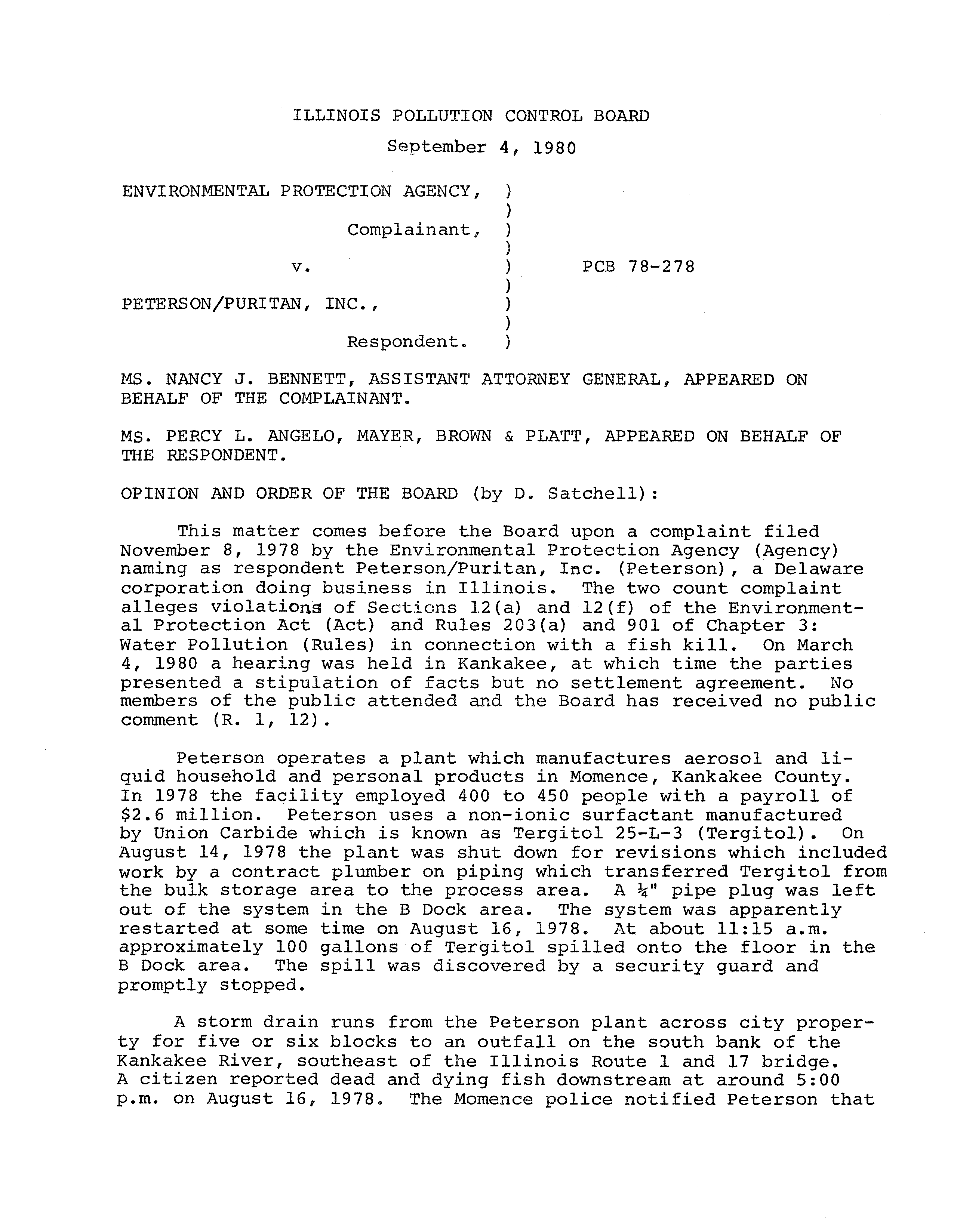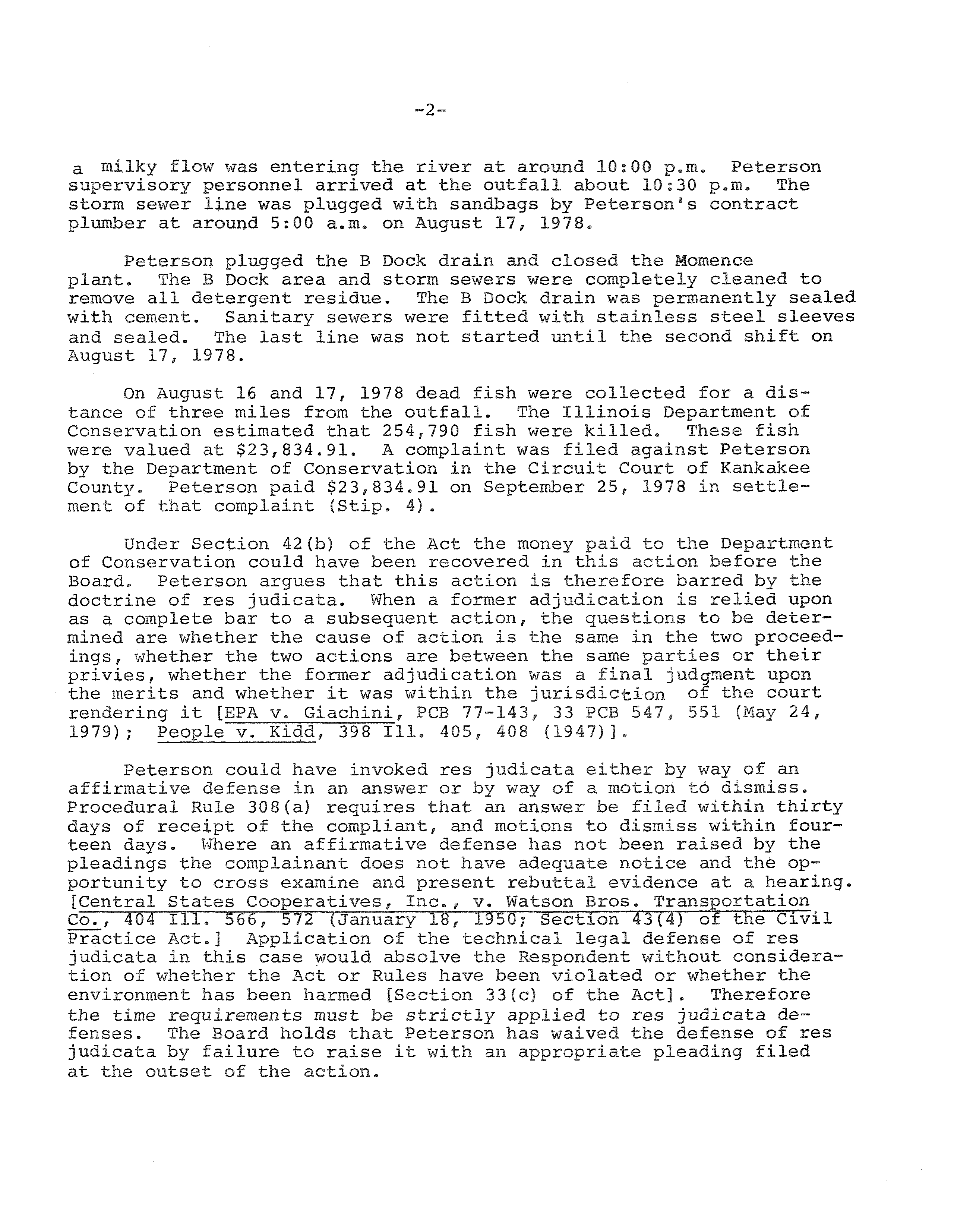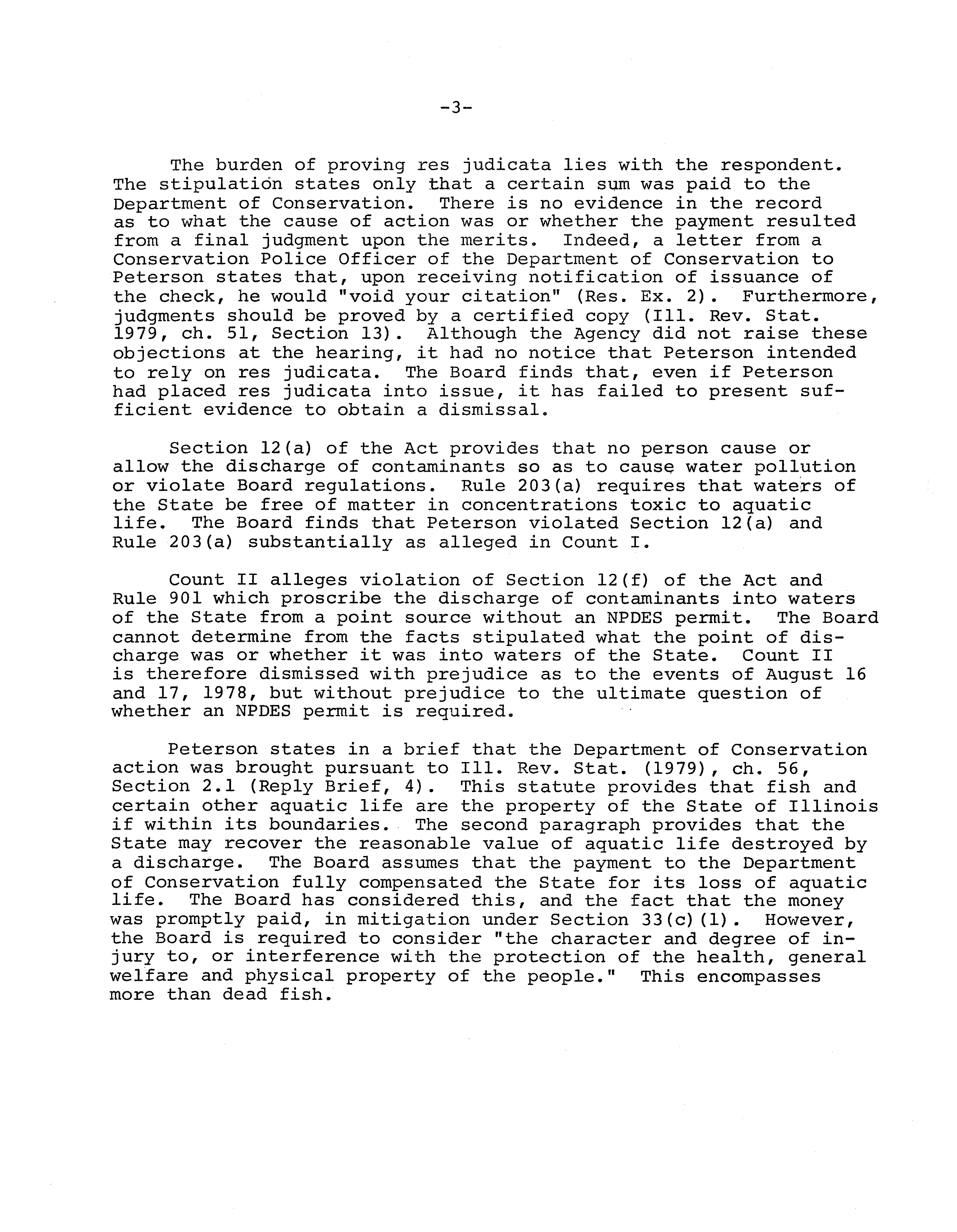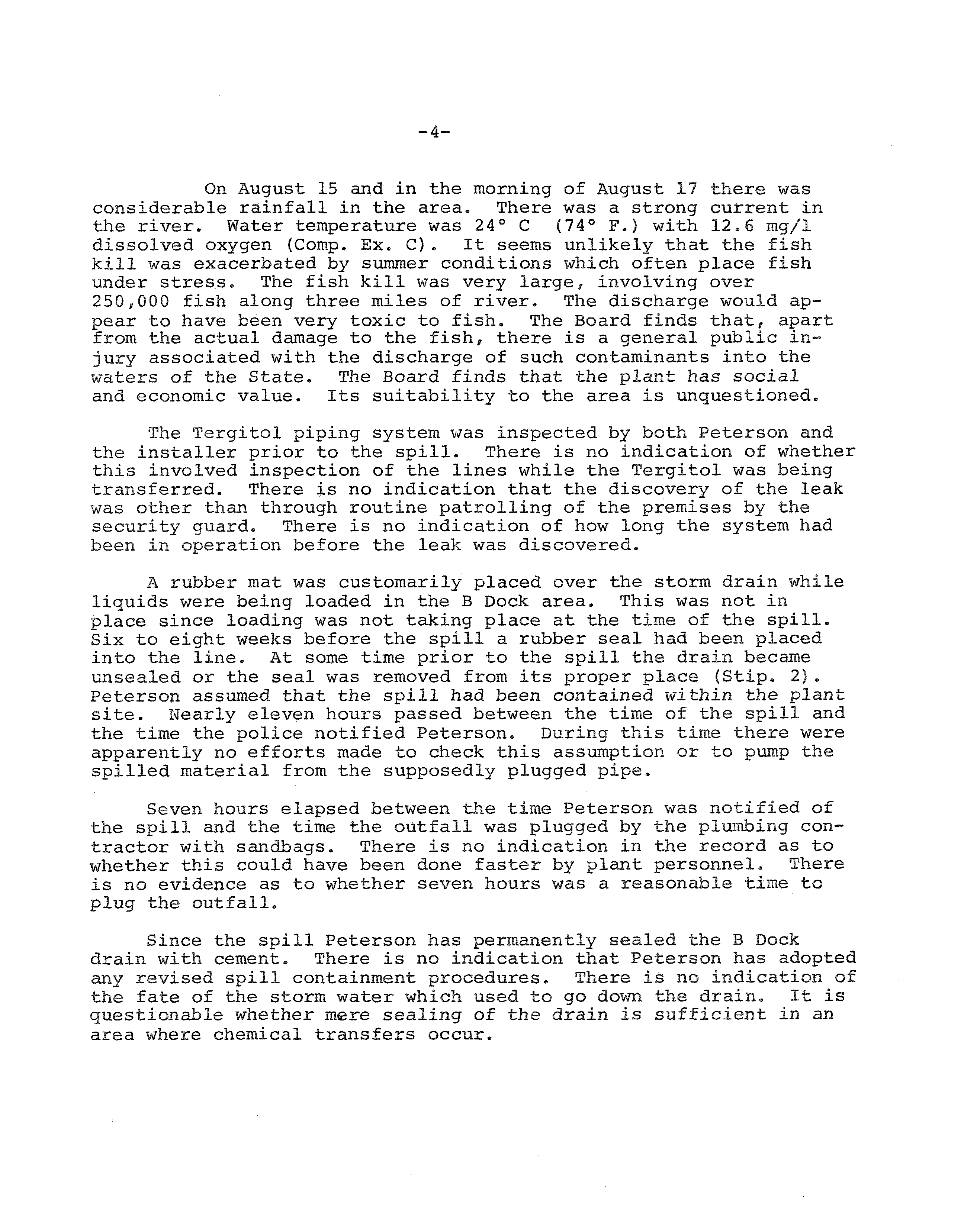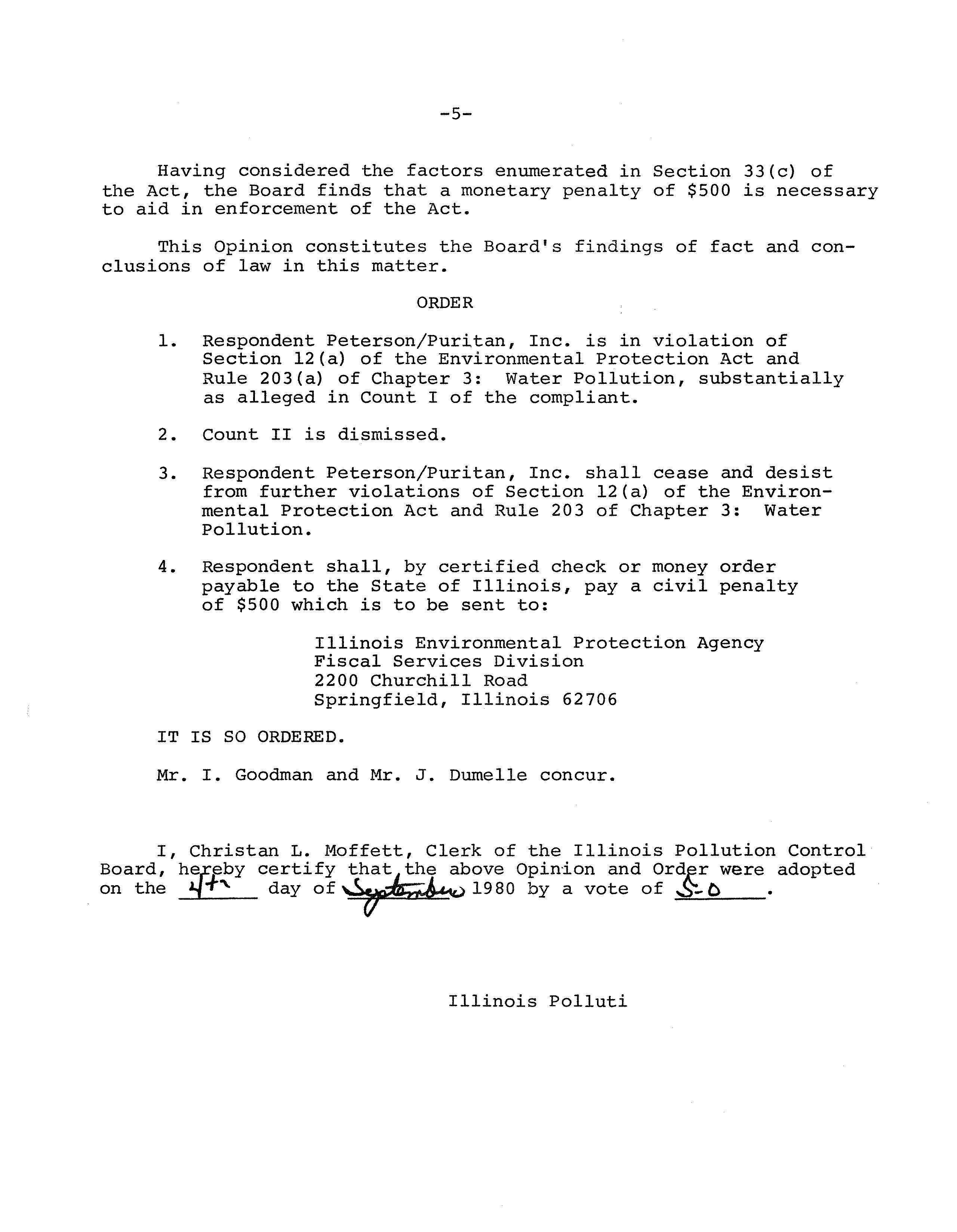ILLINOIS POLLUTION CONTROL BOARD
September 4, 1980
ENVIRONMENTAL PROTECTION AGENCY,
)
Complainant,
v.
)
PCB 78—278
PETERSON/PURITAN,
INC.,
Respondent.
MS. NANCY J. BENNETT, ASSISTANT ATTORNEY GENERAL, APPEARED ON
BEHALF OF THE COMPLAINANT.
MS. PERCY L.
ANGELO, MAYER, BROWN
& PLATT,
APPEARED
ON BEHALF OF
THE RESPONDENT.
OPINION
AND
ORDER OF THE BOARD
(by D. Satchell):
This matter comes before the Board upon a complaint filed
November
8,
1978 by the Environmental Protection Agency
(Agency)
naming
as respondent Peterson/Puritan, Inc.
(Peterson)
,
a Delaware
corporation doing business
in Illinois.
The two count complaint
alleges violations of Sections 12(a)
and 12(f)
of the Environment-
al Protection Act
(Act)
and Rules 203(a)
and 901 of Chapter
3:
Water Pollution
(Rules)
in connection with a fish kill.
On March
4,
1980 a hearing was held in Kankakee,
at which time the parties
presented
a stipulation of facts but no settlement agreement.
No
members of the public attended and the Board has received no public
comment
(R.
1,
12).
Peterson operates a plant which manufactures aerosol and li-
quid household and personal products in Momence, Kankakee County.
In 1978 the facility employed 400 to 450 people with a payroll of
$2.6 million.
Peterson uses
a non—ionic surfactant manufactured
by Union Carbide which is known as Tergitol 25-L-3
(Tergitol).
On
August 14, 1978 the plant was shut down for revisions which included
work by a contract plumber on piping which transferred Tergitol from
the bulk storage area to the process area.
A
¼”
pipe plug was left
out of the system in the B Dock area.
The system was apparently
restarted at some time on August 16,
1978.
At about 11:15 a.m.
approximately 100 gallons of Tergitol spilled onto the floor in the
B Dock area.
The spill was discovered by a security guard and
promptly stopped.
A storm drain runs from the Peterson plant across city proper-
ty for five or six blocks to an outfall on the south bank of the
Kankakee River, southeast of the Illinois Route 1 and
17 bridge.
A citizen reported dead and dying fish downstream at around 5:00
p.m.
on August 16, 1978.
The Momence police notified Peterson that
a
milky flow was entering the river at around 10:00 p.m.
Peterson
supervisory personnel arrived at the outfall about 10:30 p.m.
The
storm sewer line was plugged with sandbags by Peterso&s contract
plumber at around 5:00 a.m, on August 17,
1978.
Peterson plugged the B Dock drain and closed the Momence
plant,
The B Dock area and storm sewers were completely cleaned to
remove all detergent residue.
The B Dock drain was permanently sealed
with cement,
Sanitary sewers were fitted with stainless steel sleeves
and sealed.
The last line was not started until the second shift
on
August 17,
1978.
On August 16 and 17,
1978 dead fish were collected for a dis-
tance
of three miles from the outfall.
The Illinois Department of
Conservation estimated that 254,790
fish were killed,
These fish
were valued at $23,834.91,
A complaint was filed against Peterson
by the Department of Conservation in the Circuit Court of Kankakee
County,
Peterson paid $23,834.91 on September 25,
1978 in settle-
ment of that complaint
(Stip.
4).
Under Section 42(b)
of the Act the money paid to the Department
of Conservation could have been recovered in this action before the
Board,
Peterson argues that this action is therefore barred by the
doctrine of res judicata.
When a former adjudication is relied upon
as
a complete bar to a subsequent action,
the questions to be deter-
mined are whether the cause of action is the same in the two proceed-
ings, whether the two actions are between the same parties or their
privies, whether the former adjudication was
a final judgment upon
the merits and whether it was within the jurisdiction
of the court
rendering it
EPA
v.
Giachini, PCB 77-143,
33 PCB 547, 551
(May 24,
1979);
People
v,
Kidd,
398 Ill,
405,
408
(1947).
Peterson could have invoked res judicata either by way of an
affirmative defense in an answer or by way of a motion
to
dismiss.
Procedural Rule 308(a)
requires that an answer be filed within thirty
days
of
receipt of the compliant,
and motions to dismiss within four-
teen days.
Where
an affirmative defense has not been raised by the
pleadings the complainant does not have adequate notice and the op-’
portunity to cross examine and present rebuttal evidence at a hearing.
Central
States Cooperatives, Inc.,
v. Watson Bros.
Transportation
~0I.,572January8,;Section3otneCivil
Practice Act,
Application of the technical legal defense of res
judicata in this case would absolve the Respondent without considera-
tion of whether the Act or Rules have been violated or whether the
environment has been harmed
Section
33(c)
of the Act,
Therefore
the time requirements must be strictly applied to res judicata de-
fenses.
The Board holds that Peterson has waived the defense of res
judicata by failure to raise it with an appropriate pleading filed
at the outset of the action,
—3—
The burden of proving res judicata lies with the respondent.
The stipulatiOn states only that a certain sum was paid to the
Department of Conservation.
There
is no evidence in the record
as to what the cause of action was or whether the payment resulted
from a final judgment upon the merits,
Indeed,
a letter from a
Conservation Police Officer of the Department of Conservation to
Peterson states that, upon receiving notification of issuance of
the check, he would “void your citation”
(Res.
Ex.
2).
Furthermore,
judgments should be proved by a certified copy
(Ill.
Rev.
Stat.
1979,
ch.
51,
Section 13).
Although the Agency did not raise these
objections at the hearing,
it had no notice that Peterson intended
to rely on res judicata.
The Board finds that, even if Peterson
had placed res judicata into issue,
it has failed to present suf-
ficient evidence to obtain a dismissal,
Section 12(a)
of the Act provides that no person cause or
allow the discharge of contaminants so as to cause water pollution
or violate Board regulations.
Rule 203(a)
requires that waters of
the State be free of matter in concentrations toxic to aquatic
life.
The Board finds that Peterson violated Section 12(a)
and
Rule 203(a) substantially as alleged in Count
I.
Count II alleges violation of Section
12(f)
of the Act and
Rule 901 which proscribe the discharge of contaminants into waters
of the State from a point source without an NPDES permit.
The Board
cannot determine from the facts stipulated what the point of dis-
charge was or whether it was into waters of the State.
Count II
is therefore dismissed with prejudice as to the events of August 16
and 17,
1978, but without prejudice to the ultimate question of
whether an NPDES permit is required.
Peterson states in a brief that the Department of Conservation
action was brought pursuant to Ill.
Rev,
Stat.
(1979),
ch.
56,
Section 2.1
(Reply Brief,
4).
This statute provides that fish and
certain other aquatic life are the property of the State of Illinois
if within its boundaries.
The second paragraph provides that the
State may recover the reasonable value of aquatic life destroyed by
a discharge.
The Board assumes that the payment to the Department
of Conservation fully compensated the State for its loss of aquatic
life.
The Board has considered this,
and the fact that the money
was promptly paid, in mitigation under Section 33(c) (1).
However,
the Board is required to consider “the character and degree of in-
jury to, or interference with the protection of the health,
general
welfare and physical property of the people.”
This encompasses
more than dead fish.
—4—
On August 15 and in the morning of August
17 there
was
considerable rainfall in the area.
There was a strong current
in
the
river.
Water temperature was 24°C
(740
F.) with 12,6 mg/l
dissolved oxygen
(Comp,
Ex,
C).
It seems unlikely
that the fish
kill was
exacerbated by summer conditions which often place
fish
under stress,
The fish kill was very large,
involving over
250,000 fish along three miles of river.
The discharge would ap-
pear to have been very toxic to fish.
The Board
finds
that,
apart
from the
actual damage to the fish,
there is
a general
public in-
jury
associated with the discharge of such contaminants into
the
waters
of the State.
The Board finds that
the plant has social
and
economic value.
Its suitability to the area is unquestioned,
The
Tergitol piping system was inspected by both
Peterson and
the installer prior to the spill.
There is no indication of whether
this involved inspection of the lines while the Tergitol was being
transferred.
There is no indication that
the
discovery of
the leak
was other than
through routine patrolling of
the premises by the
security guard.
There
is no indication of how long
the system had
been in operation before the leak was discovered,
A rubber
mat was customarily placed over the storm drain while
liquids were being
loaded in the B Dock area.
This was not in
place since
loading was not taking place at the
time of the spill.
Six to eight weeks
before the spill a rubber
seal had been placed
into the line,
At some time prior to the spill the drain became
unsealed or the seal was removed from its proper place
(Stip.
2),
Peterson assumed that the spill had been contained within the plant
site.
Nearly eleven hours passed between the time of the spill and
the time the police
notified Peterson.
During this time there
were
apparently no efforts made to check this assumption or to pump the
spilled material from the supposedly plugged
pipe.
Seven hours elapsed between the time Peterson was notified of
the spill and the time the outfall was plugged by the plumbing con-
tractor with sandbags.
There is no indication in the record as to
whether this could have been done faster by plant personnel.
There
is no evidence
as to whether seven hours was a reasonable time to
plug the outfall.
Since the spill Peterson has permanently sealed the B Dock
drain with cement.
There
is no indication that Peterson has adopted
any revised spill containment procedures.
There is no indication of
the fate of the storm water which used to go down the drain.
It is
questionable whether mere sealing of the drain is sufficient in an
area where chemical transfers occur.
—5—
Having considered the factors enumerated in Section
33(c)
of
the Act, the Board finds that
a monetary penalty of $500 is necessary
to aid in enforcement of the Act.
This Opinion constitutes the Board’s findings of fact and con-
clusions of law in this matter.
ORDER
~
1.
Respondent Peterson/Puritan,
Inc.
is
in violation of
Section 12(a)
of the Environmental Protection Act and
Rule 203(a)
of Chapter 3:
Water Pollution,
substantially
as alleged in Count
I of the compliant.
2.
Count II
is dismissed.
3.
Respondent Peterson/Puritan,
Inc.
shall cease and desist
from further violations of Section
12(a)
of the Environ-
mental Protection Act and Rule 203 of Chapter
3:
Water
Pollution.
4.
Respondent shall, by certified check or money order
payable to the State of Illinois, pay a civil penalty
of $500 which is to be sent to:
Illinois Environmental Protection Agency
Fiscal Services Division
2200 Churchill Road
Springfield, Illinois 62706
IT IS SO ORDERED.
Mr.
I. Goodman and Mr.
a.
Dumelle concur.
I, Christan L. Moffett,
Clerk of the Illinois Pollution Control
Board, hereby certify that the above Opinion and Ord~rwere adopted
on the
______
day of
1980 by a vote of
~S’-c
Illinois Polluti
